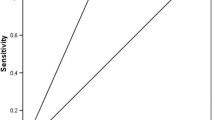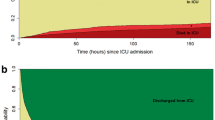Abstract
Background
Delirium remains understudied after traumatic brain injury (TBI). We sought to identify independent predictors of delirium among intensive care unit (ICU) patients with TBI.
Methods
This single-center retrospective cohort study evaluated adult patients with TBI requiring ICU admission. Outcomes included delirium days within the first 14 days, as assessed by the Confusion Assessment Method-ICU (CAM-ICU). Models were adjusted for age, sex, insurance, Marshall head computed tomography classification, presence of subarachnoid hemorrhage (SAH), Injury Severity Score (ISS), need for cardiopulmonary resuscitation, maximum admission Glasgow Coma motor score, glucose level, hemoglobin level, and pupil reactivity.
Results
Delirium prevalence was 60%, with a median duration of 4 days (interquartile range: 2–8) among ICU patients with TBI (n = 2,664). Older age, higher ISS, maximum motor score < 6, Marshall class II–IV, and SAH were associated with risk of increased delirium duration (all p < 0.001).
Conclusions
In this large cohort, ICU delirium after TBI affected three of five patients for a median duration of 4 days. Age, general injury severity, motor score, and features of intracranial hemorrhage were predictive of more TBI-associated delirium days. Given the high prevalence of ICU delirium after TBI and its impact on hospitalization, further work is needed to understand the impact of delirium and TBI on outcomes and to determine whether delirium risk can be minimized.



Similar content being viewed by others
References
Angles EM, Robinson TN, Biffl WL, Johnson J, Moss M, Tran ZV, et al. Risk factors for delirium after major trauma. Am J Surg. 2008;196(6):864–9.
Bigatello LM, Amirfarzan H, Haghighi AK, Newhouse B, Del Rio JM, Allen K, et al. Effects of routine monitoring of delirium in a surgical/trauma intensive care unit. J Trauma Acute Care Surg. 2013;74(3):876–83.
Girard TD, Thompson JL, Pandharipande PP, Brummel NE, Jackson JC, Patel MB, et al. Clinical phenotypes of delirium during critical illness and severity of subsequent long-term cognitive impairment: a prospective cohort study. Lancet Respir Med. 2018;6(3):213–22.
Mehta S, Cook D, Devlin JW, Skrobik Y, Meade M, Fergusson D, et al. Prevalence, risk factors, and outcomes of delirium in mechanically ventilated adults. Crit Care Med. 2015;43(3):557–66.
Salluh JI, Wang H, Schneider EB, Nagaraja N, Yenokyan G, Damluji A, et al. Outcome of delirium in critically ill patients: systematic review and meta-analysis. BMJ. 2015;350:h2538.
Jackson JC, Archer KR, Bauer R, Abraham CM, Song Y, Greevey R, et al. A prospective investigation of long-term cognitive impairment and psychological distress in moderately versus severely injured trauma intensive care unit survivors without intracranial hemorrhage. J Trauma. 2011;71(4):860–6.
van den Boogaard M, Schoonhoven L, Evers AW, van der Hoeven JG, van Achterberg T, Pickkers P. Delirium in critically ill patients: impact on long-term health-related quality of life and cognitive functioning. Crit Care Med. 2012;40(1):112–8.
Pandharipande PP, Girard TD, Jackson JC, Morandi A, Thompson JL, Pun BT, et al. Long-term cognitive impairment after critical illness. N Engl J Med. 2013;369(14):1306–16.
Brummel NE, Jackson JC, Pandharipande PP, Thompson JL, Shintani AK, Dittus RS, et al. Delirium in the ICU and subsequent long-term disability among survivors of mechanical ventilation. Crit Care Med. 2014;42(2):369–77.
Patel MB, Bednarik J, Lee P, Shehabi Y, Salluh JI, Slooter AJ, et al. Delirium monitoring in neurocritically Ill patients: a systematic review. Crit Care Med. 2018;46(11):1832–41.
Ely EW, Inouye SK, Bernard GR, Gordon S, Francis J, May L, et al. Delirium in mechanically ventilated patients: validity and reliability of the confusion assessment method for the intensive care unit (CAM-ICU). JAMA. 2001;286(21):2703–10.
Frenette AJ, Bebawi ER, Deslauriers LC, Tessier AA, Perreault MM, Delisle MS, et al. Validation and comparison of CAM-ICU and ICDSC in mild and moderate traumatic brain injury patients. Intensive Care Med. 2016;42(1):122–3.
Robinson D, Thompson S, Bauerschmidt A, Melmed K, Couch C, Park S, et al. Dispersion in scores on the richmond agitation and sedation scale as a measure of delirium in patients with subdural hematomas. Neurocrit Care. 2019;30(3):626–34.
Pandharipande P, Cotton BA, Shintani A, Thompson J, Pun BT, Morris JA, et al. Prevalence and risk factors for development of delirium in surgical and trauma intensive care unit patients. J Trauma. 2008;65(1):34–41.
Guillamondegui OD, Richards JE, Ely EW, Jackson JC, Archer KR, Archer-Swygert K, et al. Does hypoxia affect intensive care unit delirium or long-term cognitive impairment after multiple trauma without intracranial hemorrhage? J Trauma. 2011;70(4):910–5.
Duceppe MA, Williamson DR, Elliott A, Para M, Poirier MC, Delisle MS, et al. Modifiable risk factors for delirium in critically Ill trauma patients: a multicenter prospective study. J Intensive Care Med. 2019;34(4):330–6.
Steyerberg EW, Mushkudiani N, Perel P, Butcher I, Lu J, McHugh GS, et al. Predicting outcome after traumatic brain injury: development and international validation of prognostic scores based on admission characteristics. PLoS Med. 2008;5(8):e165.
Sessler CN, Gosnell MS, Grap MJ, Brophy GM, O’Neal PV, Keane KA, et al. The richmond agitation-sedation scale: validity and reliability in adult intensive care unit patients. Am J Respir Crit Care Med. 2002;166(10):1338–44.
Carney N, Totten AM, O’Reilly C, Ullman JS, Hawryluk GW, Bell MJ, et al. Guidelines for the management of severe traumatic brain injury. Fourth Edition Neurosurg. 2017;80(1):6–15.
Diagnostic and statistical manual of mental disorders : DSM-5. American Psychiatric A, American Psychiatric Association DSMTF, editors. Arlington, VA: American Psychiatric Association; 2013.
Girard TD, Exline MC, Carson SS, Hough CL, Rock P, Gong MN, et al. Haloperidol and ziprasidone for treatment of delirium in critical illness. N Engl J Med. 2018;379(26):2506–16.
van den Boogaard M, Slooter AJC, Brüggemann RJM, Schoonhoven L, Beishuizen A, Vermeijden JW, et al. Effect of haloperidol on survival among critically Ill adults with a high risk of delirium: the REDUCE randomized clinical trial. JAMA. 2018;319(7):680–90.
Pandharipande PP, Pun BT, Herr DL, Maze M, Girard TD, Miller RR, et al. Effect of sedation with dexmedetomidine vs lorazepam on acute brain dysfunction in mechanically ventilated patients: the MENDS randomized controlled trial. JAMA. 2007;298(22):2644–53.
Riker RR, Shehabi Y, Bokesch PM, Ceraso D, Wisemandle W, Koura F, et al. Dexmedetomidine vs midazolam for sedation of critically ill patients: a randomized trial. JAMA. 2009;301(5):489–99.
Schweickert WD, Pohlman MC, Pohlman AS, Nigos C, Pawlik AJ, Esbrook CL, et al. Early physical and occupational therapy in mechanically ventilated, critically ill patients: a randomised controlled trial. Lancet. 2009;373(9678):1874–82.
Litton E, Carnegie V, Elliott R, Webb SA. The efficacy of earplugs as a sleep hygiene strategy for reducing delirium in the ICU: a systematic review and meta-analysis. Crit Care Med. 2016;44(5):992–9.
Soltani F, Tabatabaei S, Jannatmakan F, Nasajian N, Amiri F, Darkhor R, et al. Comparison of the effects of haloperidol and dexmedetomidine on delirium and agitation in patients with a traumatic brain injury admitted to the intensive care unit. Anesth Pain Med. 2021;11(3):e113802.
Taylor CA, Bell JM, Breiding MJ, Xu L. Traumatic brain injury-related emergency department visits, hospitalizations, and deaths - United States, 2007 and 2013. MMWR Surveill Summ. 2017;66(9):1–16.
Yuh EL, Mukherjee P, Lingsma HF, Yue JK, Ferguson AR, Gordon WA, et al. Magnetic resonance imaging improves 3-month outcome prediction in mild traumatic brain injury. Ann Neurol. 2013;73(2):224–35.
Bazarian JJ, Biberthaler P, Welch RD, Lewis LM, Barzo P, Bogner-Flatz V, et al. Serum GFAP and UCH-L1 for prediction of absence of intracranial injuries on head CT (ALERT-TBI): a multicentre observational study. Lancet Neurol. 2018;17(9):782–9.
Yue JK, Yuh EL, Korley FK, Winkler EA, Sun X, Puffer RC, et al. Association between plasma GFAP concentrations and MRI abnormalities in patients with CT-negative traumatic brain injury in the TRACK-TBI cohort: a prospective multicentre study. Lancet Neurol. 2019;18(10):953–61.
Korley FK, Jain S, Sun X, Puccio AM, Yue JK, Gardner RC, et al. Prognostic value of day-of-injury plasma GFAP and UCH-L1 concentrations for predicting functional recovery after traumatic brain injury in patients from the US TRACK-TBI cohort: an observational cohort study. Lancet Neurol. 2022;21(9):803–13.
Patel MB. Illuminating Neuropsychological Dysfunction and Systemic Inflammatory Mechanisms Gleaned After Hospitalization in Trauma-ICU Study (INSIGHT-ICU): clinicaltrials.gov; 2022 [Available from: https://clinicaltrials.gov/ct2/show/NCT03098459.
Soja SL, Pandharipande PP, Fleming SB, Cotton BA, Miller LR, Weaver SG, et al. Implementation, reliability testing, and compliance monitoring of the confusion assessment method for the intensive care Unit in trauma patients. Intensive Care Med. 2008;34(7):1263–8.
Funding
This project was supported by the Vanderbilt Faculty Research Scholar Program. We used REDCap, a secure online database supported in part by the National Institutes of Health (UL1TR000445). LFS was supported by the Dr. and Mrs. G. Ashley Allen Research Grant. MRC was supported by the Vanderbilt Medical Scholars Program. MFN, DNH, ELR, and MBP, and have been supported by the National Institutes of Health (F32AG062045, R01GM120484, R01AG058639, I01RX002992, T32GM135094, T32CA10618315).
Author information
Authors and Affiliations
Contributions
MBP, LDW, JLT, and RR conceived the study, acquired the data, and created the analysis plan. LDW, AWM, SL, DNH, and MFN created an initial manuscript draft. All authors interpreted the data, critically revised the manuscript, and read and approved the final version of the manuscript.
Corresponding author
Ethics declarations
Conflict of interest
All authors declare that they have no conflicts of interest.
Ethical approval/informed consent
This article adheres to ethical guidelines, has been institutional review board approved, and was deemed exempt from requiring consent given its retrospective nature.
Additional information
Publisher's Note
Springer Nature remains neutral with regard to jurisdictional claims in published maps and institutional affiliations.
Rights and permissions
About this article
Cite this article
Wilson, L.D., Maiga, A.W., Lombardo, S. et al. Prevalence and Risk Factors for Intensive Care Unit Delirium After Traumatic Brain Injury: A Retrospective Cohort Study. Neurocrit Care 38, 752–760 (2023). https://doi.org/10.1007/s12028-022-01666-1
Received:
Accepted:
Published:
Issue Date:
DOI: https://doi.org/10.1007/s12028-022-01666-1




